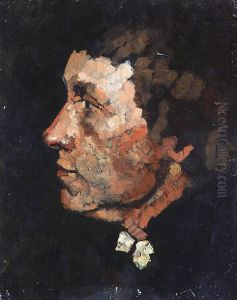Franck Duvenek Paintings
Franck Duvenek, born Frank Decker in Covington, Kentucky, was a prominent American figure and portrait painter who also had a significant impact as a teacher. His early life was marked by a change in surname to Duveneck, reflecting his stepfather's name, after his father's death and his mother's remarriage. Showing an artistic inclination from a young age, Duveneck received his initial training in Cincinnati, Ohio, before embarking on further studies in Europe, a common practice among American artists seeking to refine their skills and immerse themselves in the rich artistic traditions of the Old World.
Duveneck's time in Munich and Italy was particularly formative, leading to the development of a bold, realist painting style that stood in contrast to the more romanticized approach prevalent among many of his American contemporaries. His work from this period is characterized by a strong use of dark tones and a vigorous brushwork that captured the essence of his subjects with a remarkable immediacy and intensity. This approach not only garnered him critical acclaim but also influenced a generation of young American artists, who became known as the 'Duveneck Boys', a group of painters that followed him to Europe and studied under his guidance.
In the 1870s and 1880s, Duveneck split his time between the United States and Europe, teaching and exhibiting his work. He held teaching positions in Munich and Florence, where he met his wife, Elizabeth Boott, an American artist residing in Italy. Their partnership was cut short by her untimely death, a loss that deeply affected Duveneck and led to a temporary withdrawal from the art world. However, he eventually resumed his work and teaching, later becoming a leading figure at the Art Academy of Cincinnati, where he influenced another generation of artists.
Duveneck's contribution to American art extends beyond his paintings and includes his significant role as an educator. He was instrumental in bridging European techniques and sensibilities with American art practices, thereby shaping the direction of American art in the late 19th and early 20th centuries. His work is represented in major museums across the United States, including the Metropolitan Museum of Art and the Smithsonian American Art Museum, attesting to his enduring legacy in the American art canon. Duveneck's life and career reflect the transatlantic nature of art education and exchange in the late 19th century and his pivotal role in the development of an American art identity that was both informed by and distinct from European traditions.
